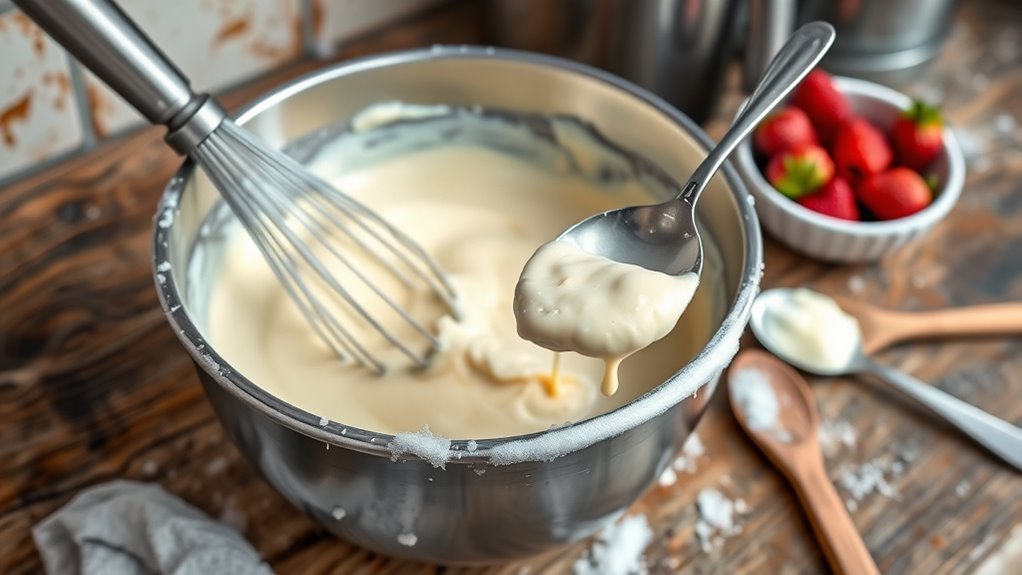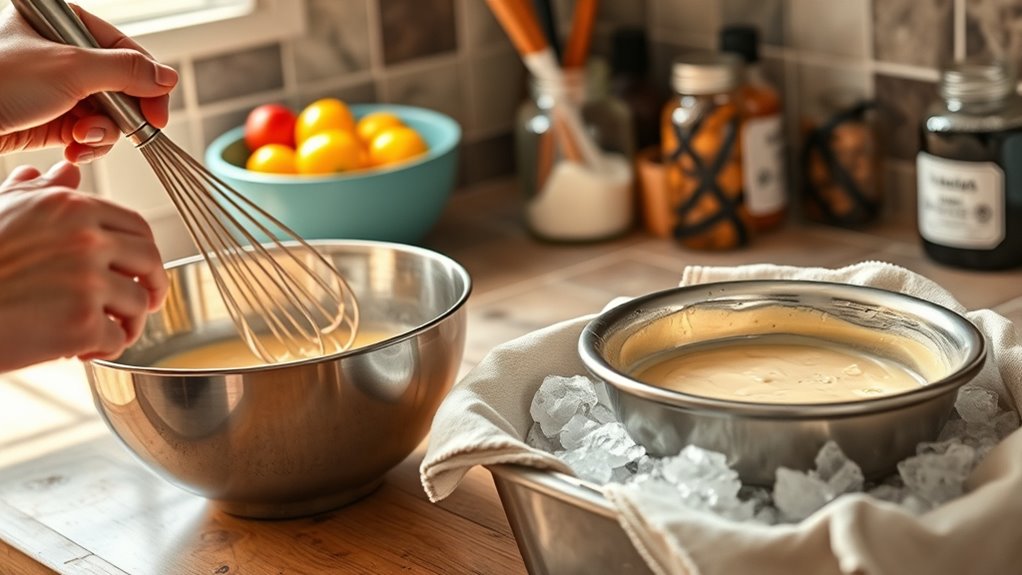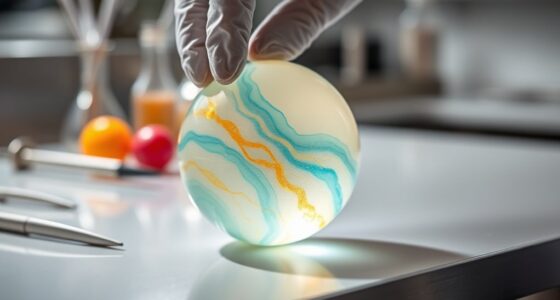Making gelato without a machine can be tricky because you need to manually stir the mixture every 30-45 minutes to prevent large ice crystals and mimic the churning process. Incorporate ingredients like alcohol, stabilizers, or fruit purees to improve texture and flavor. Patience and consistent stirring are key to achieving a smooth, creamy result. If you’re curious about advanced tips and hacks, keep exploring for more techniques to perfect your homemade gelato.
Key Takeaways
- Manual stirring every 30-45 minutes prevents large ice crystals and helps mimic machine churning.
- Incorporate alcohol, sugar, or stabilizers to lower freezing point and improve texture without a machine.
- Use a shallow container and freeze in intervals, stirring thoroughly each time to develop creaminess.
- Adding air through whisking or mixing creates a light, velvety texture similar to machine-made gelato.
- Patience and consistent interval stirring are essential to achieve smoothness and prevent hardness.

Making gelato at home without a machine is easier than you might think, and it allows you to enjoy this creamy treat with minimal equipment. While traditional techniques often rely on churning in specialized machines, you can still achieve a delicious, smooth gelato using simple methods and clever ingredient substitutions. The key is understanding how to mimic the churning process and how different ingredients affect the texture and flavor.
Without a machine, your best bet is to rely on manual techniques like stirring and freezing in intervals. Start by preparing your gelato base—whether it’s fruit, chocolate, or vanilla—then pour it into a shallow container. Every 30 to 45 minutes, take it out of the freezer and vigorously stir or whisk the mixture to break up ice crystals. Repeat this process several times to develop a creamy, smooth consistency. This manual churning mimics the continuous movement of a gelato machine, preventing large ice crystals from forming and ensuring a velvety texture.
Manual stirring and freezing in intervals create creamy gelato without a machine.
Traditional techniques for making gelato without a machine revolve around this manual stirring process. You want to pay attention to how often you stir and how thoroughly. Using a fork or a whisk, you can incorporate air into the mixture, which helps replicate the lightness of machine-made gelato. Alternatively, some people swear by using a hand-held mixer or an immersion blender during the stirring process to make it easier and more consistent. The goal is to keep the mixture from freezing solid and to create a smooth, dense consistency similar to traditional gelato.
Ingredient substitutions also play a crucial role in achieving the right texture without a machine. For instance, adding a small amount of alcohol—like a splash of liqueur—can lower the freezing point and prevent the gelato from becoming too hard. Using a higher proportion of sugar also helps, as it reduces ice crystal formation. Incorporating stabilizers such as gelatin, cornstarch, or even a bit of honey can improve the gelato’s creaminess and body. If you’re making fruit gelatos, blending in some fruit puree or juice can also help maintain a smooth consistency, especially if you reduce the water content via ingredient substitutions.
Frequently Asked Questions
Can I Make Gelato Without Any Special Tools?
Yes, you can make gelato without special tools by using hand crank methods, like a sturdy jar or a mixing bowl with a lid, which you can shake or churn manually. You might need ingredient substitutions, such as using more sugar or alcohol to prevent ice crystals. Regular stirring during freezing also helps create a smoother texture, making your homemade gelato surprisingly close to the store-bought version.
How Long Does Homemade Gelato Stay Good?
Did you know that homemade gelato typically stays good for about 1 to 2 weeks? Proper storage duration depends on how you store it; keep it airtight and at a consistent, cold temperature. To extend its freshness, avoid frequent opening and use a spatula to smooth the surface before freezing. Storage tips like covering the surface with plastic wrap help prevent ice crystals, keeping your gelato delicious longer.
What Flavor Combinations Work Best Without a Machine?
You can create fantastic flavor combinations without a machine by experimenting with fruit infusions and spice pairings. Try blending berries with a hint of cinnamon, or mango with ginger for vibrant tastes. Incorporate fresh fruit purees and infuse them with spices to enhance richness and depth. These combinations work well with no-churn techniques, giving you delicious gelato flavors that impress, even without specialized equipment.
Is It Possible to Make Vegan Gelato at Home?
Yes, you can craft vegan gelato at home, transforming your kitchen into a frozen paradise. Imagine blending creamy coconut milk or cashew cream, rich dairy alternatives that mimic traditional textures. Use vegan substitutes like maple syrup or agave for sweetness and flavor. With a little patience, stirring every 30 minutes, you’ll create a silky, dairy-free treat that rivals classic gelato, delighting your taste buds with every spoonful.
How Do I Prevent Ice Crystals From Forming?
To prevent ice crystals from forming, you should stir your gelato frequently during freezing to improve texture and evenly distribute the cold. Using ingredients like alcohol or sugar enhances flavor and keeps the mixture smooth. Incorporating a stabilizer or adding fats can also improve texture, preventing crystals. Keep the mixture well-chilled before freezing, and consider covering it tightly to avoid air exposure, ensuring your gelato stays creamy and flavorful.
Conclusion
Without a machine, making gelato feels like chasing a whisper of creamy perfection, each stir a dance of patience and passion. As you fold in flavors and watch the mixture freeze, imagine a cool, velvety spoonful melting on your tongue, transporting you to a quieter, sweeter world. Though challenging, your homemade gelato becomes a tangible piece of summer’s magic, a chilled symphony crafted by your own hands—delicious, dreamy, and uniquely yours.








